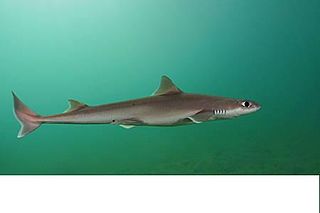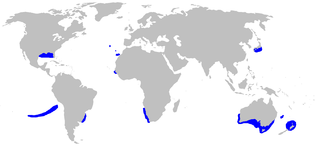
The Squaliformes are an order of sharks that includes about 126 species in seven families.
The Centrophoridae are a family of squaliform sharks. The family contains just two genera and about 15 species. They are sometimes called gulper sharks, but this is also the name of a specific species in the family, Centrophorus granulosus. These are generally deepwater fish. While some, such as the gulper shark C. granulosus, are found worldwide and fished commercially, others are uncommon and little-known. Their usual prey is other fish; some are known to feed on squid, octopus, and shrimp. Some species live on the bottom (benthic), while others are pelagic. They are ovoviviparous, with the female retaining the egg-cases in her body until they hatch.
Squalidae, more commonly known as dogfish, dog sharks, or spiny dogfish, are one of several families of sharks categorized under Squaliformes, making it the second largest order of sharks, numbering 119 species across 7 families. Having earned their name after a group of fishermen reportedly observed the species chasing down smaller fish in dog-like packs, dogfish have slender, streamlined bodies, usually more compact in comparison to other species, and a pointed snout. Dogfish likewise have two dorsal fins, each with smooth spines, but no anal fin, and their skin is generally rough to the touch. As the species reaches adulthood, males usually measure a maximum of 100 cm, while females typically measure 125 cm long. The species therefore exhibits female-dominant sexual dimorphism.

The spiny dogfish, spurdog, mud shark, or piked dogfish is one of the best known species of the Squalidae (dogfish) family of sharks, which is part of the Squaliformes order.

The school shark is a houndshark of the family Triakidae, and the only member of the genus Galeorhinus. Common names also include tope, tope shark, snapper shark, and soupfin shark. It is found worldwide in temperate seas at depths down to about 800 m (2,600 ft). It can grow to nearly 2 m long. It feeds both in midwater and near the seabed, and its reproduction is ovoviviparous. This shark is caught in fisheries for its flesh, its fins, and its liver, which has a very high vitamin A content. The IUCN has classified this species as critically endangered in its Red List of Threatened Species.

The bramble shark is one of the two species of sharks in the family Echinorhinidae. Aside from the eastern Pacific Ocean, it is found in tropical and temperate waters worldwide. This rarely encountered shark swims close to the bottom of the seafloor, typically at depths of 400–900 m (1,300–3,000 ft), though it may enter much shallower water. The bramble shark has a stout body with two small dorsal fins positioned far back and no anal fin. It can be readily identified by the large, thorn-like dermal denticles scattered over its body, some of which may be fused together. It is purplish brown or black in color and grows up to 3.1 m (10 ft) long.

The dumb gulper shark is a rare and endangered deepwater dogfish, found along the east coast of Australia and in isolated spots north and west of New Zealand. It is also known as the dumb shark, Harrison's deep-sea dogfish, or Harrison's dogfish.

The leafscale gulper shark is a dogfish of the family Centrophoridae. C. squamosus is reported to have a lifespan of approximately 70 years, based on otolith ring counts. It was the first described species in the genus Centrophorus, which now contains 13 species.

The little gulper shark is a small, deepwater dogfish of the family Centrophoridae.

The birdbeak dogfish is a dogfish shark of the family Centrophoridae found in the Pacific Ocean around Honshū, Japan, southern Australia, New Zealand, and Chile, and in the Atlantic Ocean from Iceland south to the Cape of Good Hope.

The rough longnose dogfish is a little-known deepwater dogfish. This species was described by Samuel Garman in 1906 and originally named Acanthidium hystricosa.

The arrowhead dogfish is a small little known deepwater dogfish of the family Centrophoridae.

The longsnout dogfish is a little-known deepwater dogfish, found in the Atlantic and Indian Oceans from Namibia to Mozambique and in the South Pacific off southern Australia and New Zealand.

The black dogfish is a species of dogfish shark in the family Etmopteridae. It is common over the outer continental shelf and continental slope at depths of 180–2,250 m (590–7,380 ft). Females generally inhabit deeper water than males, and depending on the region, smaller sharks may occur at different depths than larger ones. This species is distributed widely in the Atlantic Ocean, from Greenland and Iceland to Virginia and West Africa in the north, and off southwestern Africa and Argentina in the south. The largest member of its family, the black dogfish, typically measures 60–75 cm (24–30 in) long. It has a stocky, dark brown body that is darker below than above, and bears scattered, minute bioluminescent organs. Its two dorsal fins are preceded by stout spines, and the anal fin is absent.

The kitefin shark or seal shark is a species of squaliform shark in the family Dalatiidae, and the type species in its genus. It is found sporadically around the world, usually close to the sea floor at depths of 200–600 m (660–1,970 ft). With a sizable oil-filled liver to maintain neutral buoyancy, this shark is able to cruise slowly through the water while expending little energy. The kitefin shark, the largest luminous vertebrate on record, has a slender body with a very short, blunt snout, large eyes, and thick lips. Its teeth are highly differentiated between the upper and lower jaws, with the upper teeth small and narrow and the lower teeth large, triangular, and serrated. Its typical length is 1.0–1.4 m (3.3–4.6 ft), though examples as long as 5.9 ft (180 cm) have been encountered.

The roughskin dogfish is a sleeper shark of the family Somniosidae, found around the world on continental shelves in tropical, subtropical and temperate seas, at depths of between 100 and 1,500 m. It reaches a length of 121 cm.

The mandarin dogfish is a dogfish, a member of the family Squalidae in the order Squaliformes. It is found at depths of 140–650 metres (460–2,130 ft) off southern Japan, Taiwan, and Indonesia. Populations off Australia and New Zealand were formerly included in this species, but in 2007 these were assigned to a new species, the southern mandarin dogfish. It is not clear which of these species is involved in other populations from the tropical West Pacific.

The Portuguese dogfish or Portuguese shark, is a species of sleeper shark of the family Somniosidae. This globally distributed species has been reported down to a depth of 3,675 m (12,057 ft), making it the deepest-living shark known. It inhabits lower continental slopes and abyssal plains, usually staying near the bottom. Stocky and dark brown in color, the Portuguese dogfish can be distinguished from similar-looking species by the small spines in front of its dorsal fins. Its dermal denticles are also unusual, resembling the scales of a bony fish. This species typically reaches 0.9–1 m (3.0–3.3 ft) in length; sharks in the Mediterranean Sea are much smaller and have distinct depth and food preferences.

The southern Mandarin dogfish is a species of Mandarin dogfish shark in the genus Cirrhigaleus. It was distinguished from Cirrhigaleus barbifer, which lives in the North Pacific, on an expedition in the coral reefs near Australia in 2007. It is now known to live in the temperate waters in south-eastern Australia and from the Bay of Plenty region in New Zealand, at depths of 146–640 metres.

















